Thank you dear subscribers, we are overwhelmed with your response.
Your Turn is a unique section from ThePrint featuring points of view from its subscribers. If you are a subscriber, have a point of view, please send it to us. If not, do subscribe here: https://theprint.in/subscribe/
After four failed rounds of negotiations with the government, it appears that the farmers and their tractors are ready to set their March towards Delhi. Their key demands include an MSP guarantee on 23 crops, withdrawal from FTAs related to agriculture, no FDI in agriculture, no corporatization of farming, farm loan waivers and monthly pensions for farmers to name a few.
Much has been written about the possible financial implications of these demands. This article is more concerned about the other issues concerning agriculture but hardly discussed in the public sphere.
The first among them is ‘insurance.’ A report published in the magazine- Down to Earth says that since 2016, there has been a 62% decrease in farmers covered under crop insurance during the Kharif season and a 46% decrease during the Rabi season. Furthermore, the report mentions ‘very low’ and ‘delayed’ compensation as one of the major reasons for this decrease.
However, the problem is considerably larger. Among the 9.3 crore agricultural households, hardly 2.3 crores are insuring their crops. The Situation Assessment Survey of agricultural households says that 40-50% of ‘farmers not insuring their crops’ do so simply because they are not aware of crop insurance. While 15% are not aware of the availability of insurance facilities, 20% are not interested in insurance. Given the increasing instances of climate change, shouldn’t the issue of insurance be the top priority for farmers and the government?
Second on the list is loans. Loans not only in terms of its amount but also in terms of its source and purpose. As per the report, 50.2% of agricultural households are indebted. Among them, one in every five farmers (20.5%) takes loans from traditional moneylenders who often charge a higher interest rate. It is necessary to bring every farmer into a formal credit cycle. Secondly, only 57.5% of loans are taken for capital expenditure in agriculture. The rest is for revenue expenditure, housing, marriages, ceremonies, education, medical etc. It is necessary to demarcate the line between these purposes. It should be ensured that concessional loans taken in the guise of agricultural loans should be spent only on capital assets to increase their income and prevent them from entering a debt trap cycle.
The third issue hovering over agriculture is ‘soil health.’ The government has launched a range of initiatives from PM- Paramparagat Krishi Vikas Yojana to PM-PRANAM. Despite that, 2018-19 data says that 82.2% of agricultural households are using chemical fertilizers. The share of bio-fertilizers is at only 13.9%. The government’s allocation towards fertilizer subsidy has increased from 70,090.35 crore rupee (2018-19) to 1.64 lakh crore rupee (2024-25). Thus, it should not be a tall order to guess how much the situation has improved since 2018.
The issue of irrigation also demands urgent attention. With only 31.1% of agricultural households having access to irrigation, it is essential to provide every farmer and every farm, access to irrigation irrespective of its land size. The government has created an ambitious plan to interlink every major and minor river to increase access to irrigation. However, the success of this plan will only depend on the level of cooperation it receives from different state governments.
Now we turn our attention to one of the most important issues- technical advice accessed by farmers. In this era of rapid evolution, farmers are exposed to a range of challenges such as climate change, crop diseases, and abnormalities in rainfall patterns among others, something that they need to overcome. It is also imperative for farmers to adapt to new technologies coming into the market to increase their productivity. It will happen only if the farmers can access the ‘technical advice.’ So where does this advice come from? Let’s take a look-
Percentage of agricultural households accessing technical advice from different sources:
| Source | Percentage of agricultural households |
| Krishi Vigyan Kendra | 1.3 |
| Govt. extension agent | 3.1 |
| Agricultural University/college | 0.3 |
| Veterinary department | 6.6 |
| Kisan call center | 1.5 |
| Progressive farmers | 22.8 |
| Input dealers | 19.9 |
While the progressive farmers and input dealers provide valuable advice, other sources mentioned in the list are the ones, which are known for providing real-time scientific solutions to evolving problems. The low dependency of farmers on these sources is a serious issue.
These are some of the issues responsible for stagnation in agriculture and demand urgent intervention by policymakers.
Note-1: Majority of the data mentioned in the article is taken from Situation Assessment Survey of agricultural households (2018-19).
Note 2: This is the first article in a two-part series. The second article will focus on income-related issues and the inter-state disparity between farmers.
These pieces are being published as they have been received – they have not been edited/fact-checked by ThePrint.

